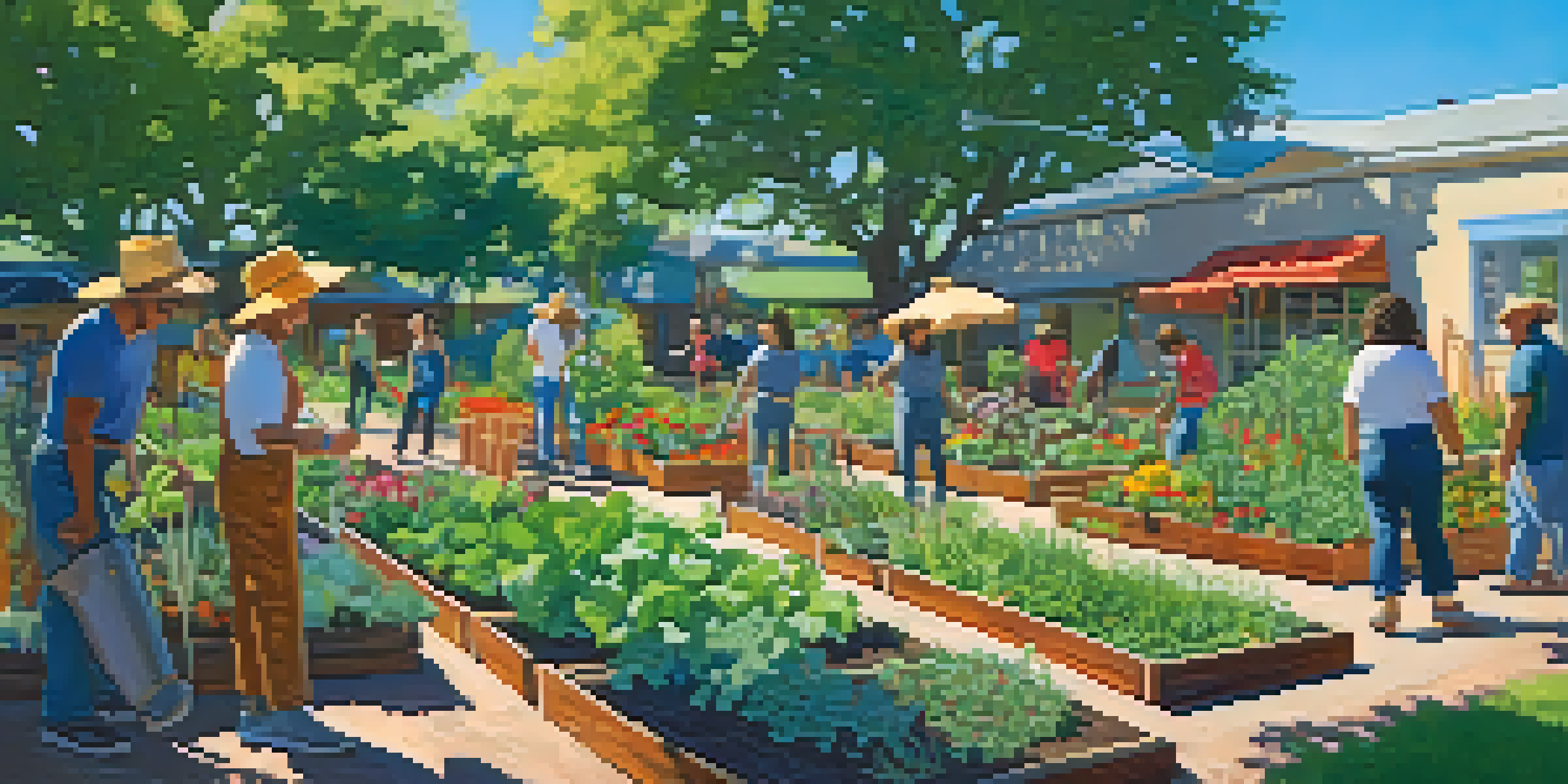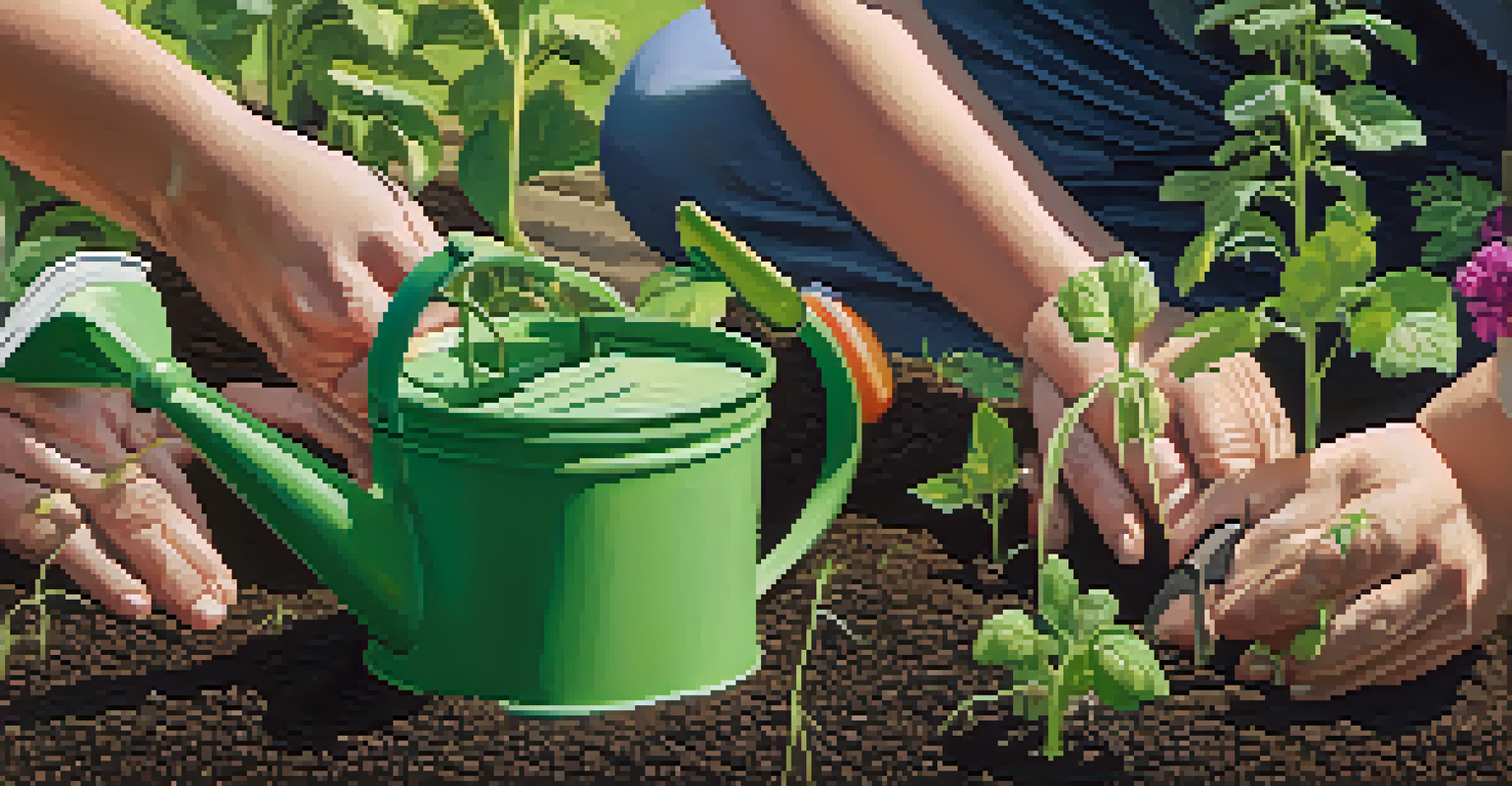Connecting Neighbors Through Austin's Community Gardens

The Growth of Community Gardens in Austin
Austin has seen a remarkable rise in community gardens, transforming backyards and vacant lots into green havens. These spaces not only beautify neighborhoods but also serve as gathering spots for residents. The city's commitment to sustainability and local food production has fueled this growth, making gardening accessible to everyone.
To plant a garden is to believe in tomorrow.
With over 50 community gardens across the city, residents have the opportunity to cultivate their own plots while sharing knowledge and resources. This initiative promotes biodiversity and helps reduce the carbon footprint by encouraging local food consumption. It's a win-win for the environment and the community.
Moreover, these gardens often reflect the diverse cultures of Austin, showcasing a variety of plants and gardening techniques. Whether it's a traditional Southern vegetable garden or an herb garden inspired by international cuisines, each plot tells a unique story. This diversity enriches the community and fosters a sense of belonging.
Building Community Ties Through Gardening
Community gardens serve as a natural hub for residents, creating opportunities for connection and collaboration. Neighbors come together to plant, tend, and harvest, often sharing tips and recipes in the process. These shared experiences cultivate friendships that extend beyond the garden’s borders.

The act of gardening itself promotes teamwork and communication, as participants learn to work towards common goals. Whether it’s organizing a planting day or hosting a harvest festival, these activities foster a sense of ownership and pride within the community. It’s amazing how a little dirt under your nails can lead to lasting relationships.
Community Gardens Foster Connection
These gardens serve as hubs for residents to bond over shared gardening experiences, cultivating friendships and a sense of belonging.
Gardens also provide a space for people of all ages, encouraging multi-generational interactions. Children learn the basics of gardening from their elders, while adults can share their skills and experiences. This intergenerational exchange enriches the community and helps preserve gardening traditions for future generations.
Cultural Exchange in Austin's Gardens
Austin's community gardens are melting pots of cultural exchange, where diverse backgrounds coexist and flourish. Gardeners often share seeds, plants, and even traditional growing methods that reflect their heritage. This exchange not only diversifies the types of produce grown but also enriches the community's culinary landscape.
The best time to plant a tree was twenty years ago. The second best time is now.
Events like potlucks and cultural festivals frequently take place in these gardens, allowing residents to showcase their culinary skills. Imagine tasting a dish from a neighbor's home country while learning about its significance. This sharing of food and stories fosters understanding and appreciation among residents.
Additionally, community gardens often host workshops and classes that celebrate various cultural gardening techniques. From Mexican salsa gardens to Asian stir-fry plots, these educational opportunities allow participants to expand their gardening repertoire. It’s a wonderful way to learn and honor the traditions that shape our food systems.
Promoting Sustainability Through Community Efforts
Sustainability is at the heart of Austin's community gardens, which emphasize eco-friendly practices. Many gardens implement composting systems, rainwater collection, and organic gardening methods to reduce their environmental impact. These practices not only benefit the garden but also inspire participants to adopt sustainable habits at home.
By growing their own food, community members reduce reliance on store-bought produce, which often comes with a carbon footprint. Plus, gardening organically helps maintain healthy soil and biodiversity, contributing to the overall health of the local ecosystem. It’s a powerful reminder of how small actions can make a big difference.
Sustainability Through Gardening
Community gardens promote eco-friendly practices and reduce reliance on store-bought produce, contributing to a healthier local ecosystem.
Moreover, community gardens often collaborate with local environmental organizations to promote awareness of sustainability issues. Workshops on topics like pollinator gardens and native plants educate residents on how they can enhance their gardens while supporting local wildlife. Together, they nurture a greener Austin.
Health Benefits of Gardening Together
Gardening is not only good for the community; it’s also beneficial for individual health. Engaging in physical activity, even in small doses, can improve fitness levels and overall well-being. Plus, the act of nurturing plants can have therapeutic effects, reducing stress and promoting mental health.
Many community gardens also emphasize the importance of nutrition by encouraging members to grow their own fruits and vegetables. The availability of fresh, organic produce can lead to healthier eating habits, benefiting the entire community. It’s a delicious way to support both physical health and community wellness.
Furthermore, these gardens often become spaces for health-related workshops, such as cooking classes and nutrition education. Participants learn how to prepare meals using fresh ingredients from the garden, making healthy eating more accessible. It’s not just about growing food; it’s about cultivating a healthier community.
Challenges Faced by Community Gardens
Despite their many benefits, community gardens in Austin face several challenges, including funding and land access. Many gardens rely on donations or grants to maintain operations, which can be unpredictable. Securing a long-term lease for garden space is also essential for ensuring sustainability.
Additionally, community gardens often need to navigate local regulations and zoning laws that may restrict their activities. Understanding these legalities can be daunting for garden coordinators, making it crucial for them to stay informed and engaged with local government. Advocacy efforts can help ensure that community gardens have the support they need to thrive.
Cultural Exchange Enriches Community
Austin's gardens celebrate diverse cultural backgrounds through shared gardening techniques and culinary traditions, enhancing community understanding.
Moreover, maintaining participation and enthusiasm from community members can sometimes be a hurdle. Busy schedules and changing priorities can lead to dwindling involvement. However, fostering a strong sense of community and celebrating achievements can help keep spirits high and encourage ongoing participation.
The Future of Austin's Community Gardens
Looking ahead, the future of Austin's community gardens appears bright, fueled by community passion and support. As more residents recognize the benefits of gardening, interest in joining these spaces continues to grow. This trend encourages the establishment of even more gardens throughout the city.
Innovative ideas, such as vertical gardens and rooftop plots, are emerging to maximize urban gardening opportunities. These new approaches can help address challenges related to space and land access, ensuring that gardening remains viable in an ever-evolving city landscape. The future is about adaptability and creativity.

Moreover, increasing partnerships with local schools, businesses, and organizations can further enhance the impact of community gardens. Collaborative initiatives can lead to more resources, knowledge sharing, and opportunities for community engagement. Together, we can cultivate a thriving network of gardens that connect neighbors and nourish our city.